WHO WE ARE
ABOUT 1881
1881 Napa was created in one of the Napa Valley’s oldest historical Victorian homes with a mission to celebrate the origins of America’s premier winemaking region and the pioneers that founded it. The history of 1881 Napa is tied inextricably to that of its neighbor, the Oakville Grocery. At the gateway to the Napa Valley stands a landmark historical Victorian home and the oldest continuously operating grocery store in California, founded in 1881. This beloved general store served the visionary pioneers who first planted grapes in the valley. The adjacent founder’s home at the junction of Oakville today honors the rich history, legacy and heritage of this world-famous wine region. Known as 1881 Napa, it presents the appellations of Napa Valley to provide a comprehensive discovery of its diversity, abundance, world-renowned terroir and deep history.
1874
The earliest records of the home and store date to at least 1874. The Oakville Grocery building stood in 1874 where it stands today: near the center of a one-acre square abutting the main north/south county road (now Highway 29) and an east/west road, now the Oakville Crossroad. Its doors were already open when the St. Helena Star ran an ad in its November 19, 1874 edition touting P. B. O’Neil’s “dry goods, groceries, and hardware store” in Oakville. The store’s name has varied over the years between “Oakville Grocery” and “Oakville Mercantile,” but its location and purpose have been primarily the same, longer than any other store in Napa County.
1878
When an Oakland-based publishing company named Smith & Elliott came to the Napa Valley in 1878 to create a book of lithographs describing the local history and architecture, they included a rendering of what they called “the former Ish place."The residence,” Smith & Elliott wrote, “is the finest in that part of the county.”
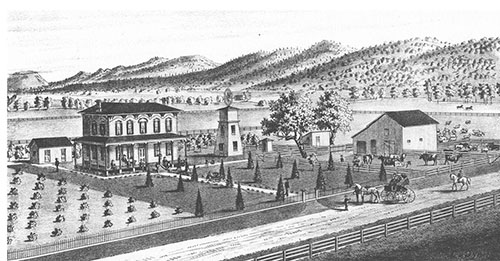

1881
A June 10, 1881 Napa County Reporter advertisement reported on “Oakville Station—Where James McQuaid officiates as Railroad agent, Postmaster, and Wells, Fargo and Company’s agent, also dispensing at a reasonable figure, all kinds of general merchandise to people of the vicinity, from a calico dress to a keg of tenpenny nails.” McQuaid tended the store and trotted across the county road to the train stop several times a day to assume his role as a railroad agent.
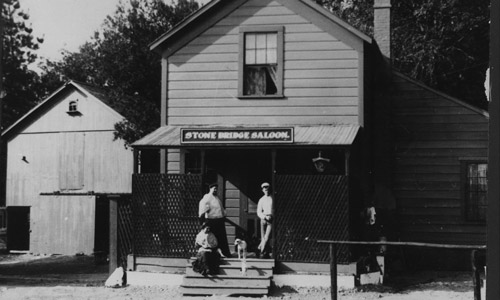

As the article showed, he also served as the postmaster, housing the Oakville post office in his store. Pioneer Oakville vintner William Locker was the first Oakville post-master. This essential gathering place for Oakvillans may have been located at the railroad depot during O’Neil’s time but was definitely in McQuaid’s store by 1881. The ad suggests that the McQuaids did not specialize in the sale of groceries, although they were sold at the Oakville Mercantile as they would have been in any general store at the time, especially when there was no other place nearby where residents could buy staples. The store’s success lured others into trying their hand at retail sales nearby, including a blacksmith and a butcher shop. At least two saloons went into business to “serve the men of the community” and offered wine from the nearby wineries. The transition from wheat farming to grape growing and winemaking was well underway, and times were good.
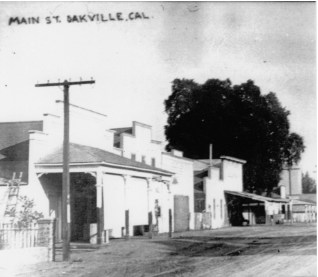

1900
The following years were transitional for Oakville. The fire and the phylloxera situation across the vineyards closed some doors but opened many others for those in the wine industry. More shoppers came to the store, in search of hard-to-get items. Other shops and buildings popped up in Oakville, as cars replaced buggies, and real estate magnates, business tycoons and wealthy families flocked to the area.
Weathering through Prohibition and the Great Depression - two events catastrophic for the premium California wine industry - the Oakville store shifted focus to high-end culinary products, including artisan cheeses, spices and a selection of caviars never seen in the area.
The property changed hands a couple times in the following decades and benefited from a great culinary boom in the 1970s. Other Oakville Groceries popped up in the Bay Area, and the future of the business seemed unstoppable until an economic downturn in the early 2000s and the accumulation of years of age. Both the grocery and the adjacent house was in need of serious repair.


2018
Jean-Charles Boisset was born in 1969 in Vougeot, France, an ancient and iconic viticultural area in Burgundy. His father is a vintner, and the family own historically significant vineyards and wineries throughout France. Growing up with such antiquity around him, JCB has a passion for history. He finds much satisfaction in rehabilitating worthy old vineyards by applying natural remedies that restore health to the vines while safeguarding the ecosystem. As in the case of the Durant & Booth house and the Oakville Grocery, worthy old buildings are also the recipients of his love for restoration.
Jean-Charles has lovingly transformed the Durrant & Booth house into an interactive museum where guests can learn about the specific elements that make the wines of the Napa Valley so unique. Each of the 16 subregions in the Napa Valley appellation has its distinguishing characteristics as well as its history. Both the house and the store draw attention to the year 1881 when the Oakville Grocery's roots first really took hold as a mainstay in the heart of the Napa Valley.
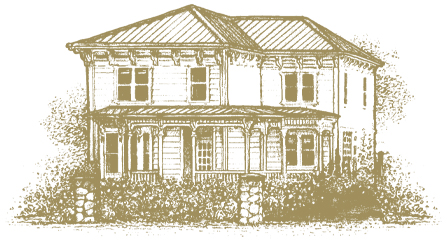

Immediately to the north of the store in 1874 was the large, elegant, two-story house now known as 1881 Napa. Its original owner appears to have been a wheat farmer named John Garner. He sold the one-acre, including the house, to a fellow wheat farmer, Carroll W. Ish in 1875. While wheat's importance as a cash crop was declining in Oakville, the future for grapes and wine looked increasingly promising. Local wine was sold commercially in Napa for the first time in 1857 and was flowing in a steady stream in the Napa Valley by the mid-1860s, especially around St. Helena, which was 6 miles to the north. By the 1870s vintners were on the way to perfecting their craft. Vineyards replaced wheat fields all around Oakville.


While Smith & Elliott were writing their history and preparing their lithographs, the Oakville Grocery and the land on which it stood changed hands several times, from the Ishes to John Garner to P.B. O’Neil to a wheat farmer named T. J. Roberts and another wheat farmer named James. J. McIntire and his wife Elizabeth, to a former gold-miner-turned-quicksilver-miner, Jim McQuaid.
Jim and his much younger wife Jennie would become the first to make a go of it. The St. Helena Star wished Jim well in an April 1877 issue, linking the endeavor’s viability with wheat farming: “He is going to try his luck in the mercantile line for a while. May he be successful. Farmers are jubilant over the prospects for big prices for their wheat this year.” Wheat was still driving Oakville’s economy, but that would soon change.


1884
Things hummed along nicely for the McIntires and McQuaids until 1884, when a tragedy in the McIntires’ family changed things in the McQuaids’. Elizabeth McIntire was thrown from a wagon in which she was riding and died of her injuries, along with one of her children. The grieving James McIntire sold the store, the house and the one acre they stood on to Jim and Jennie for $700.
Years of mining caught up to Jim. His health deteriorated. It is possible that Jennie divided her time between managing the store and raising their daughters, Ethel and Cynta. Depending on Jim’s health, she might also have run the post office. When Jim became too sick to work, a German named Melchior Kemper Sr. bought Oakville Mercantile (its name at the time). Jim McQuaid passed away on August 4, 1889.
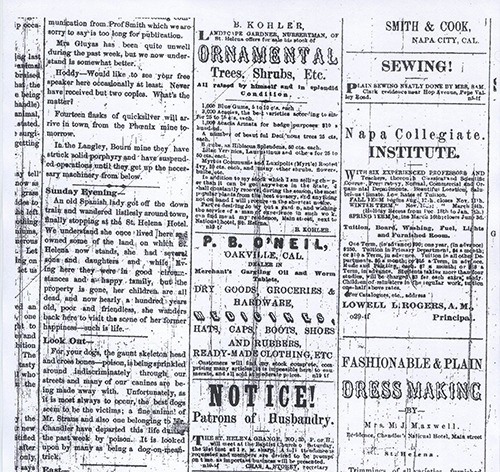

1893
Tragedy struck again the night after the Fourth of July, 1893. Shortly after midnight, the elder Kemper and Mel Jr. were awakended by a bright light coming from the store, where they found the back room of the store on fire. The blaze spread quickly, accelerated by the explosion of two cans of powder and 10,000 cartridges the Kempers stored. Oakville Mercantile, the barn, the blacksmith's and Walters' shop burned down, but the Victorian was spared, minus blown out windows on the south side of the house.
Mel Sr. supervised the rebuilding of the store but eventually moved to Vallejo and died in 1909. Thanks to loans from her relatives, as well as insurance money and the subsequent sale of the store, Jennie was able to spend her second widowhood in comfort in Vallejo until her death in 1914.
After the reconstruction, the Durrant and Booth families purchased the store as well as the adjacent Victorian house from Jennie and Mel Kemper Sr. and set about expanding the store.
2007
In 2007, Leslie Rudd - who had purchased Dean & DeLuca in 1996 - purchased Oakville Grocery and the Victorian. Rudd loved history and had bought and restored several historic buildings around the country. He hired Guy Byrne, a contractor sensitive to the painstaking and delicate task of retaining all salvageable elements, and restored both buildings. The Victorian home was renamed the Durrant & Booth house and used for administrative purposes. When Leslie passed away in 2018, Jean-Charles Boisset purchased the property.


1881 Napa Today
1881 Napa today, restored to its original glory, stands as a testament to these hardy founders and pioneers, not only of its own plot, but in honor of all those that made had a vision for Napa Valley to one day become the destination for grape growing and fine wine which has earned Napa its international reputation.
VISIT US
7856 St. Helena Hwy, Oakville, CA 94562.
Adjacent to the Oakville Grocery
Open Monday through Thursday, 12:00 pm to 5:00 pm, and Friday through Sunday, 10:30 am to 5:00 pm

